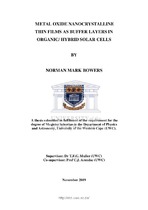| dc.contributor.advisor | Muller, T.F.G. | |
| dc.contributor.advisor | Arendse, C.J. | |
| dc.contributor.author | Bowers, Norman Mark | |
| dc.date.accessioned | 2020-12-04T09:46:13Z | |
| dc.date.available | 2020-12-04T09:46:13Z | |
| dc.date.issued | 2019 | |
| dc.identifier.uri | http://hdl.handle.net/11394/7698 | |
| dc.description | >Magister Scientiae - MSc | en_US |
| dc.description.abstract | Without reverting to encapsulation, organic bulk - heterojunction solar cells
can be protected from the oxidation of the highly reactive low work function
cathode metal electrode, by the deposition of metal oxide buffer layers onto
an indium-tin oxide (ITO) substrate. The zinc-oxide (ZnO) or titanium
dioxide (TiO2) layer can serve as an electron collecting contact. In such a
case the ordering of layer deposition is inverted from the traditional layer
sequencing, using an additional effect of the metal oxide layer acting as a
hole blocking contact | en_US |
| dc.language.iso | en | en_US |
| dc.publisher | University of Western Cape | en_US |
| dc.subject | Nanocrystalline | en_US |
| dc.subject | Metal oxide | en_US |
| dc.subject | Solar cell | en_US |
| dc.subject | Spin coating | en_US |
| dc.subject | Electron blocking | en_US |
| dc.title | Metal oxide nanocrystalline thin films as buffer layers in organic/ hybrid solar cells | en_US |
| dc.rights.holder | University of Western Cape | en_US |

